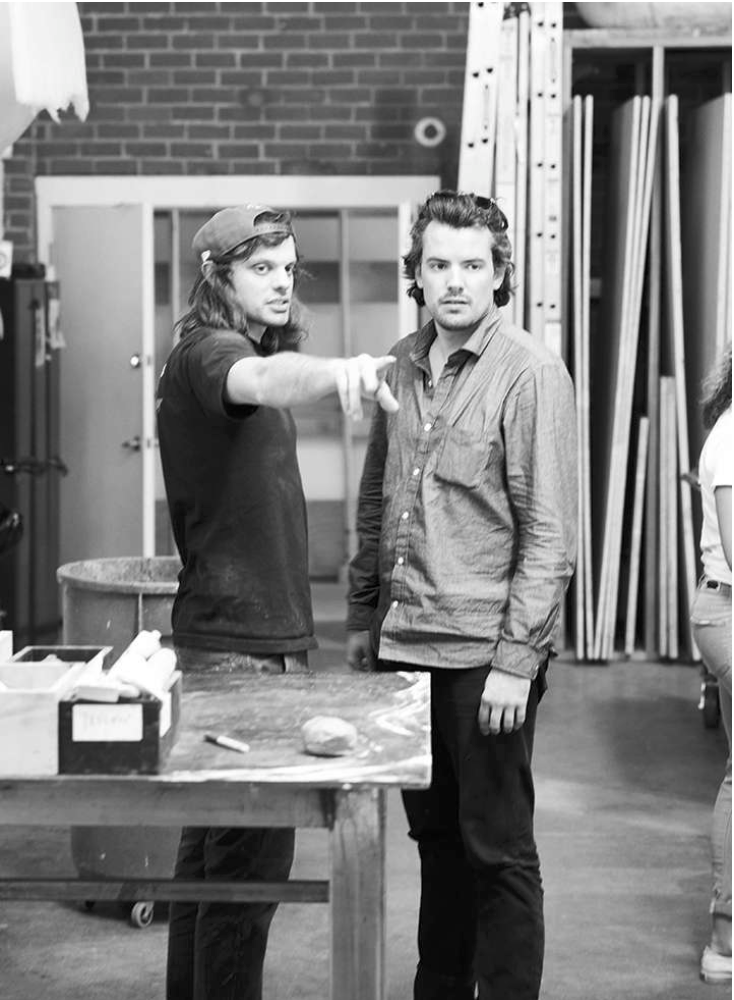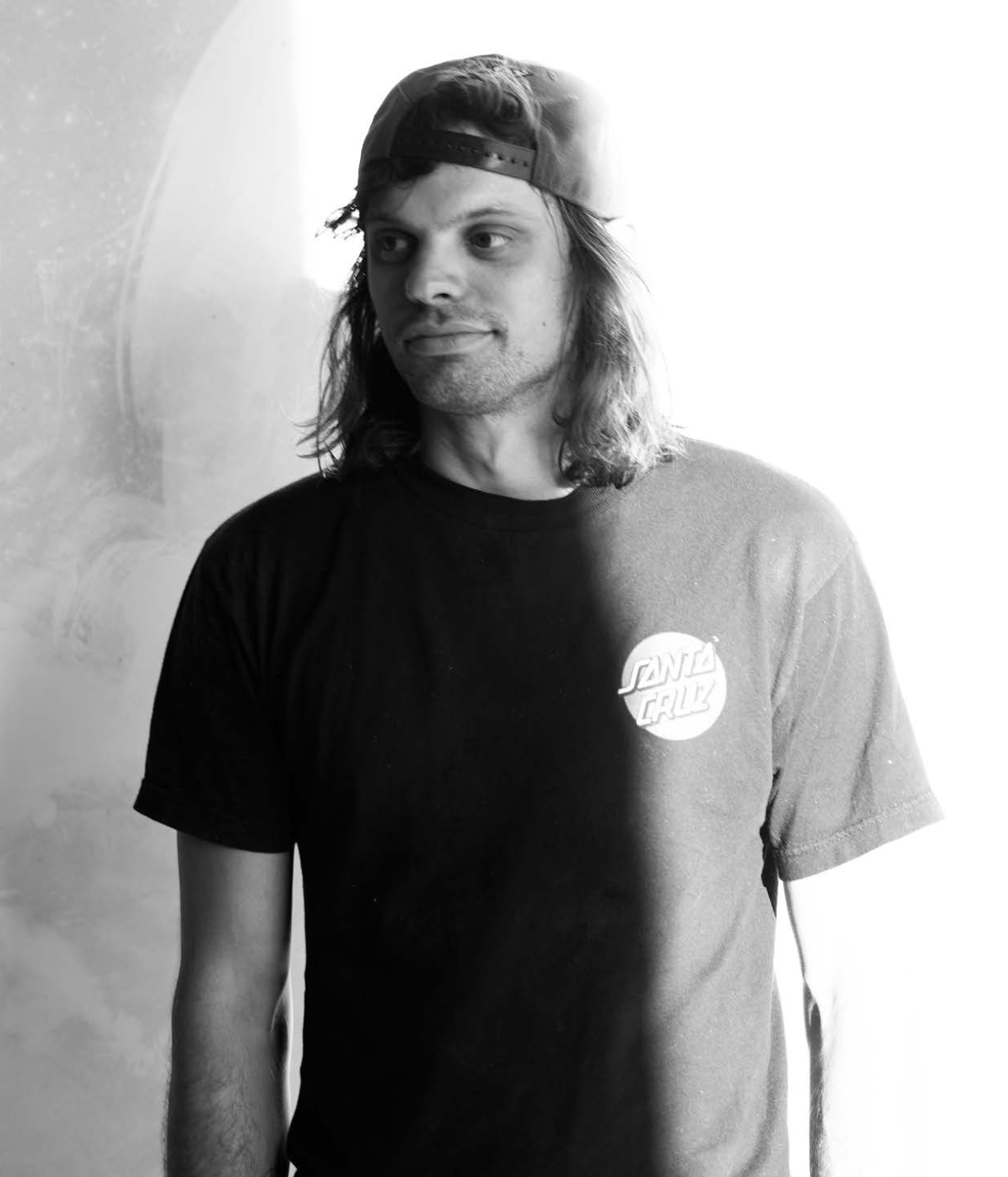HAAS BROTHERS
Interview by Michael Bullock
Photography by Daniel Trese
PIN-UP 16, 2014

TALKING SEX, NUTS, AND BOLTS WITH THE DESIGN WORLD’S WINSOME TWINS
In 2006 Nikolai Haas abandoned a college hockey scholarship to join the band RRIICCEE, convincing his twin brother Simon, who was then studying painting, to do the same. RRIICCEE, which specialized in experimental noise, was the brainchild of the actor Vincent Gallo, and part of the premise was never to rehearse. “We were going on stage with absolutely nothing to offer, just trying to come up with something,” laughs Nikolai. Unpopular with audiences and critics alike, the group disbanded. But the short-lived experience instilled a fearlessness in both brothers. “It definitely taught us to let go of inhibitions,” says Nikolai. Four years later the twins took another leap of faith: they quit their day jobs — Simon as a chef and Nikolai as a construction manager — and took a lease on a warehouse in downtown L.A. with the intention of making furniture. It’s there they began creating their trademark pieces which, forgoing any obedience to the modernist precepts of efficiency and clean lines, address two subjects rarely covered in design school: humor and sex. Their creations, many of which require up to three weeks’ hand labor by a staff of 13, include organically shaped tables veneered in brass tiles, and elaborate ceramics that appear to be covered in barnacles. High-profile clients soon started knocking on their door, including Roman Alonso (who asked the brothers to draw murals for the Ace Hotel in Los Angeles); Peter Marino (who commissioned a reflective ceiling from them for the Guerlain store in Paris), and Donatella Versace, who hired the pair for last year’s widely publicized Versace home collection.
In person, Simon and nikolai are charismatic and funny. It’s clear the two bring out the best in each other, being the yin to each other’s yang, and often finishing each other’s sentences in true twin fashion. And while their meteoric rise to design stardom may appear unexpected, for Nikolai and Simon it’s actually a step back toward their childhood roots.
Did you grow up here in L.A.?
Nikolai Haas: No, we actually grew up in Austin, Texas. But since we were little we’ve always spent a lot of time in L.A.
Simon Haas: Because of our brother [the actor Lukas Haas]. Thanks to him we had a childhood filled with really bizarre and unusually famous people. And also because of our mom, who was a screenwriter for Seinfeld and The Cosby Show. We grew up with this good friend of my mom’s, he was like our adopted uncle. We called him Uncle Terry. And we knew he made movies but we couldn’t really appreciate his films when we were little. I didn’t realize until I was 22 that, holy shit!, uncle Terry is Terrence Malick, and he’s a fucking genius! So we grew up with a lot of great influences. Our parents were cool when they were younger and living in L.A.
I imagine it might have been stressful growing up with an older brother who was so successful, and you’re still figuring out who you are.
SH: Not really. he’s so much older than us, about nine years...
NH: ...and he was already successful before we were even in middle school.
SH: And as twins we had a good support system, so we never worried about it that much. He was really supportive and brought us into these bizarre circles that nobody else got to go into. It was special. we thought it was cool.
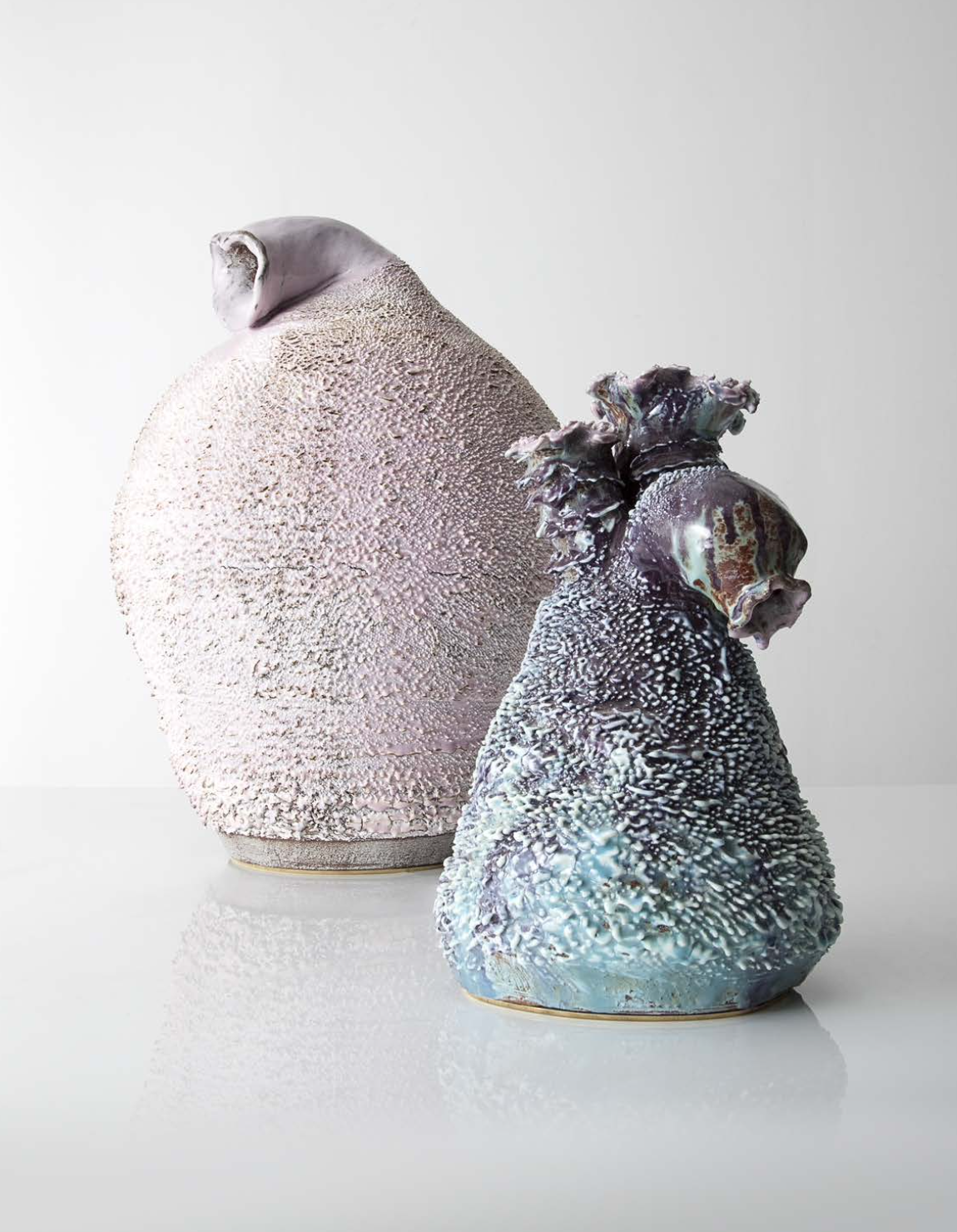
Did you make stuff growing up?
NH: Yes, our dad had a furniture company and he was also a stonemason when we were kids. I learned his trade very quickly. Simon did too.
SH: If there was ever an issue with the stone, I would faux- paint it. now I can perfectly match any stone... you have no idea! [Laughs.]
NH: My job was running our dad’s crew, or driving the pickup truck, or carving. It was super physical.
So you actually grew up with design. A lot of the press about you guys makes it sound like your design career came completely out of the blue.
NH: We’ve come out of the blue in the sense that we found our voice quickly. Whereas before, when Simon was painting or I was playing music, those weren’t the proper venues for us yet.
But once you started collaborating...
NH: ...we started plugging back into what we really know. When you’re playing guitar or drums, you’re supposed to be able to get on stage and not think about the technical aspect of it. That’s what we’re doing here. We’re really fluid. There’s not even a second question about how to build something because we’ve been doing it since we were kids, so there’s no hindrance in a technical, emotional, or expressive sense. Creative people often struggle with self-doubt, but as twins I imagine you can get each other past that.
SH: We always experienced the same shit at the same time so we can just say something and the other one gets it without thinking about it.
NH: There’s also the mutual support you were talking about. If you’re feeling down the other can lift you up. There’s also a dynamic of developing opposing talents.
A lot of twins hate being compared to each other.
SH: Identical twins have that more often. we didn’t have that problem growing up. But as kids, for example, niki wouldn’t talk on the phone.
NH: I couldn’t. Simon would make every single phone call for me.
Why?
NH: I don’t know. It’s just the way it happened. It wasn’t even a choice. I didn’t even realize it until I was 18 and Simon and I didn’t live together anymore. I would ask myself, “Why do I have this major anxiety when I use the phone?” It was because up until then Simon had made every single phone call for me.
SH: And I got anxiety when I had to drive by myself....
NH: ...because I always drove. Simon and I don’t have that in our personal lives anymore because we live in separate places. But professionally we have very specific roles in the company. They’re difficult to explain because there’s lots of crossover, but to us it’s always clear who’s going to do what. I usually sculpt the forms and Simon invents material application. He invented the ceramic accretion process, the hex-tiling, and the vermiculated leather.
SH: I’m a nerdy, obsessive, know-it-all freak when it comes to anything technical. Before I fall asleep at night I start wondering about things. Like why does a ball sack shrink in the way that it does, and how can I make that happen?
[Laughs.]
NH: It’s a good question.
SH: I obsess over it and then I have to figure it out. I sewed for
20 hours. I had no idea what it was going to look like but it
turned out right. I was like, “Fuck yeah! That’s so good!”
NH: I’ll go to sleep at night thinking, “What is fashion? How does art play into design? Where are they moving? The line of sight?” I like conceptual questions. Simon does too, he writes an essay on every piece of furniture that we make. I’ll express it in a sketch. I usually do all the sketches.
SH: My sketches are more tedious. My desire for perfection hinders my ability to be free with formal stuff. My designs are generally lackluster. Niki knows how to be free from that.
And how about studio management?
NH: In general, I’ll run the shop floor. I’m more involved with
telling people what to do because I’m comfortable with it. Simon is more reclusive, but he comes up with what everyone needs to be doing.
I read that Simon called himself the “fun mother.”
SH: Niki called me the “bitchy mom” and I said I was the “fun
mom.” I’m like the “drunk mom.”
NH: I think I’m the “stern father,” but also loving. I think our
employees really like us.
SH: No one would ever tell us if they didn’t. [Laughs.] It’s
satisfying to be able to provide a job for somebody. But I
can’t manage people at all. I get mad.
NH: He’ll get frustrated. That’s the only reason I call him the
“bitchy mom” because...
SH: It’s because I’m a queer! It’s because you’re a homophobe.
[Laughs.]
Did you have to come out to him?
NH: Simon didn’t come out until we were 19.
SH: My mom fucking did it. She walked in on me making out with this guy and freaked out and then she asked Niki, “Did you know Simon is gay?"
NH: I said, “What’s the big deal?” She cried for a week. She made it her thing.
SH: She told everybody. I didn’t get to tell very many people myself.
NH: I already knew. I’d had a feeling since high school.
SH: In high school I was an unpopular nerd but protected because Niki was a popular jock so nobody would fuck with me.
Your new body of work explores sexuality.
NH: Yeah. we’re doing a sex room for Design Miami Basel this year.
SH: It’s going to be a little bit like a video store, where you have regular films in the front, and then there’s a backroom with porn. we’re going to have a regular exhibition and a backroom.
NH: But they’ll tie into each other.
SH: We hate the idea that sexuality is criminalized. we grew up having these restrictions that we put on ourselves, with sex, drugs, or whatever. We both grew up feeling that. I couldn’t figure it out until I left Texas.
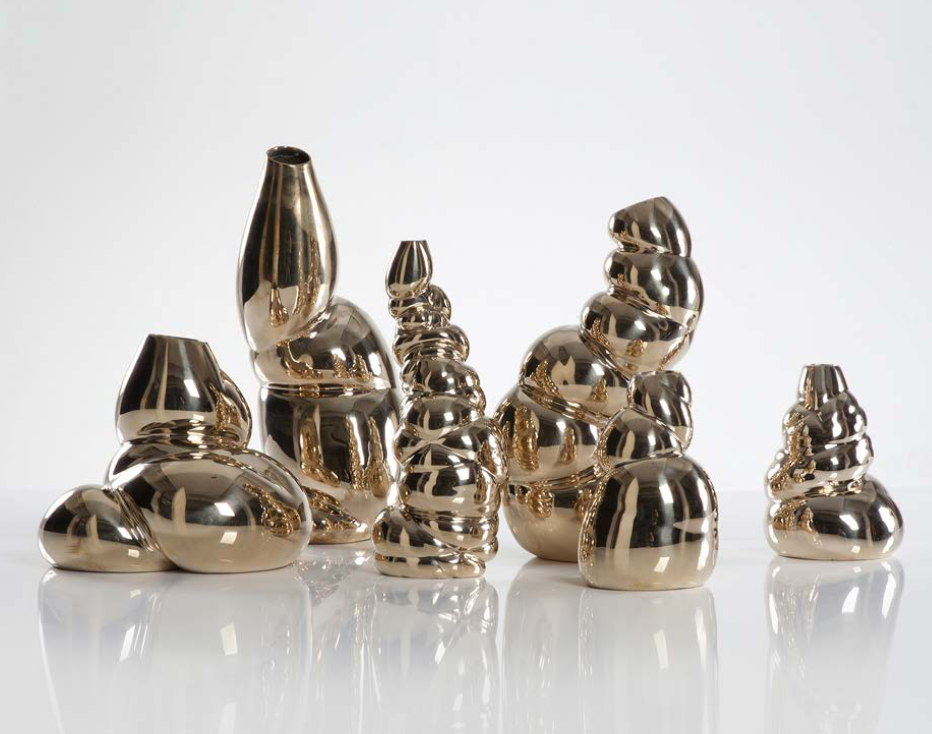
Because of your parents?
SH: No, just society and culture in Austin is very...
NH: Our parents too. Our mom grew up conservatively in Texas and our dad is a German Catholic. Although they shed those personalities, the fact that our mom cried for a week when her son came out is a pretty good mirror of the fact that she’s not as open as you’d think. It’s ridiculous that someone would cry because their son is gay. It’s like, “Wow, you’re crying because your son sucks dick? So do you. what’s the big deal?!” [Laughter.] I’m serious. we’ve given ourselves a difficult task because we want to convey explicit sexuality, but with no shock value.
SH: In a very sweet way.
NH: Sweet, subtle, and private.
Like Georgia O’keeffe?
NH: Georgia O’Keeffe’s not explicit enough. She’s uses the flower. This is going to be full-on sex.
SH: The idea is for people to have an immediate response to something, and hopefully, get turned on. Each viewer will experience the work alone in a private room. So a straight dude can touch something that feels like a nut sack and no one will know.
NH: That’s going to happen!
SH: Maybe they’ll let themselves enjoy it because they’re alone. That’s the idea.
NH: It could say that they’re gay, but it could also say they’re straight but get turned on by touching a ball sack.
So on the Kinsey Scale they might be more of a two than they thought?
NH: Yes. most people fall into that. I don’t believe that anyone can watch any kind of sex, or be next to it, and not feel some sort of arousal, at least intellectually. There’s nothing ugly about sex. Sex is hot. whether its gay, or straight, or bisexual, or whatever.
SH: We want to promote a positive sexuality. It’s tricky because we could go over the edge and make people go, “Oh, whatever!” There’s still a chance it will be annoying or offensive to some people. But we would love to pull this off and not have that happen.
SH: Our goal is for everyone to feel happy when they leave that room. we had a piece at Design miami in Basel last year called The Dolph, and it was a tall stool with animal legs and a furry top. In the back we included a gold nut sack, which you couldn’t see at first. We’d tell people, “There’s a little surprise back there!”
NH: And conservative women wearing million-dollar diamond necklaces got on their knees to grab it. And then they’d lighten up, start talking and hanging out. All of a sudden you can relate to that person like a human being, not like they’re a potential client. We like being able to change people’s minds about things. That’s why we choose to explore sexuality and humor. Those are human ways you can speak to somebody on a serious level. You start with a joke, and after that they’re engaged. It’s so basic but also taboo.
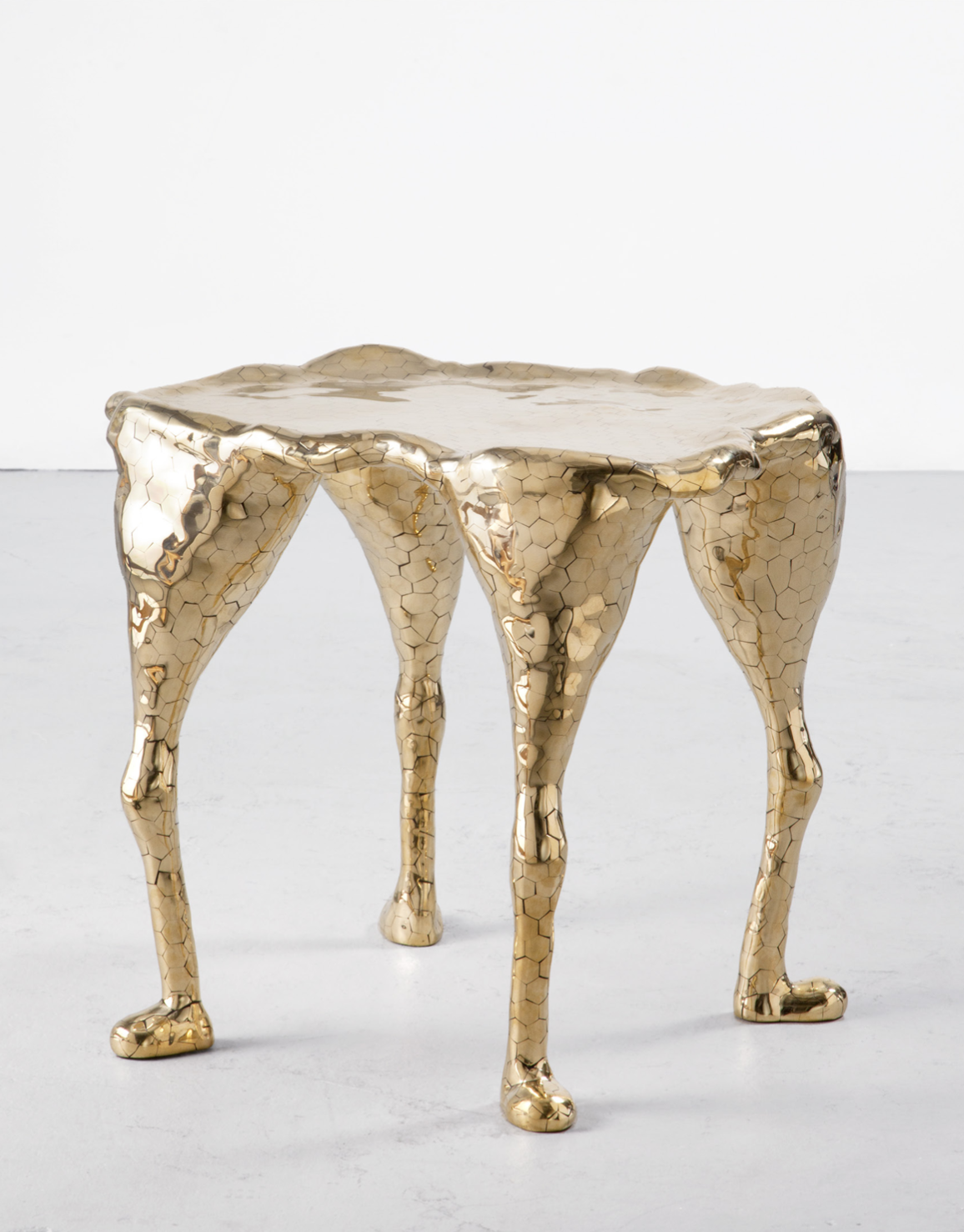
The hex-tiled tables were your breakthrough, and now they’ve become your signature pieces. How did they come about?
SH: We had a hexagonal brass rod that I thought was gorgeous. hexagons have the greatest number of sides you can have on a regular geometric grid; there’s more volume compared to grout lines than if you had a square, so it makes sense if you want to cover an organic shape.
NH: That’s why bees make hexagons!
SH: It’s the most efficient coverage you can have so it makes
sense to use them for tiles. I thought if we could use a solid brass one, we could grind it. Plus the idea of removing all the facets and having a reflection that denies the geometry.
NH: It looks like liquid.
SH: The reflection looks like water. But then you see it’s a grid.
It makes a disconnect in your brain because it doesn’t look
like it should be geometry, but it is. That’s visually exciting.
So when you made the first one you knew that was it?
SH: Oh yeah.
NH: But we’ve really perfected the process now. Our gallerist
owns our first stool and when we look at it, we’re like, “Please don’t show it to anyone!”
SH: It’s still awesome, but now we’ve got it so tight.
NH: I defy another shop to figure out how to make it that great.
SH: When we did the Versace home project there was supposed to be a production piece with the hexagon tile. When we brought it to their manufacturers they said, “No, we’re not doing that.”
NH: We even made a manual to explain the process but...
SH: ...they asked us to do it.
How was working with Donatella Versace?
SH: She was awesome. I was caught off guard because in the fashion world she’s the most legendary person you could ever hope to meet. She could have been the scariest bitch ever.
NH: But she was fantastic.
SH: Super sweet, really energetic, very youthful. We went to meet her in a huge marble room at the Versace building on Fifth Avenue in new york. She was sitting on a white leather sofa, smoking. We spread out all this stuff in front of her and she just said, “Love, love!” She was getting so excited about it.
SH: She was sort of hard to understand, though.
So she lived up to the fantasy you had of her?
SH: Totally. It makes sense that she was Gianni’s muse because she’s great at inspiring people to do stuff. you feel it when you’re around her. She also has the sharpest eye. when she sees stuff it’s a quick “no, no, no,” or “yes, yes, yes!”
NH: You might not expect it, but she has very good taste.
SH: She knows exactly what she wants. We had a huge pile of ideas and she edited it down. She didn’t change anything we designed, she just chose what she wanted.
NH: We also weren’t resisting the collaboration. We wanted to convey the house. That was the whole point. At that stage we were furniture designers who’d done very little: one group show and about six things — a stool and some bronze vases. That was it.
How did she even find you?
SH: A friend introduced us to this guy, Pierre Rougier, who does her P.R. When we went to meet him he said, “why am I meeting you?”
NH: We showed him photos and he was like, “Wow, this is pretty good. Okay, I have a client that might like your stuff. Let me get back to you.” We got an email from her office a week later.
SH: The same day we showed Donatella that hexagonal material, we showed it to the gallery R & Company, and they also signed us on the spot.
Wow! what was in your star charts that day?
SH: We should find out! [Laughs.]
NH: The reason we like to work in fashion is that it has this
insane P.R. machine. We’ve realized the value of that. Working in fashion is fun because it’s temporary, but it gives you a really large voice that allows you to speak to a large group of people at the same time. you don’t normally have that privilege making sculpture or furniture.
Yes, the press junkets by design companies are much smaller.
NH: Not even close!
What’s your favorite thing you’ve made so far?
SH: Oh damn! [To Nikolai:] Do you have a favorite thing?
NH: I’m so proud of that glaze that Simon just made, which
changes colors. It’s genius, and no one’s done anything like
that. And making them perfect is insane.
So no one has ever used it as a glaze before?
SH: I’ve seen two science experiments.
NH: no one’s patented it, for sure.
SH: We can patent the recipe, but someone could replicate it if
they figured out some of the ingredients. We just can’t talk
about what’s in it.
What will the glaze be called?
NH: Changeum. [Laughs.]
SH: All our names are jokes. We have Changeum 10 and
Changeum 20. we wanted it to sound like how drug
companies name their drugs.
Like in Avatar?
NH: Yeah, “Unobtainium!” It’s a nod to that. after the movie, we were like, “Where’s the Hardtogetium?” [Laughs.]
NH: Check the archive on our website, you can see all the names for our furniture: Anna Nicole Jr., or Debby Hairy. One glaze is called Sissy Space Egg.
SH: Furniture and paint names can be so annoying. We wanted to make it as silly as it gets.
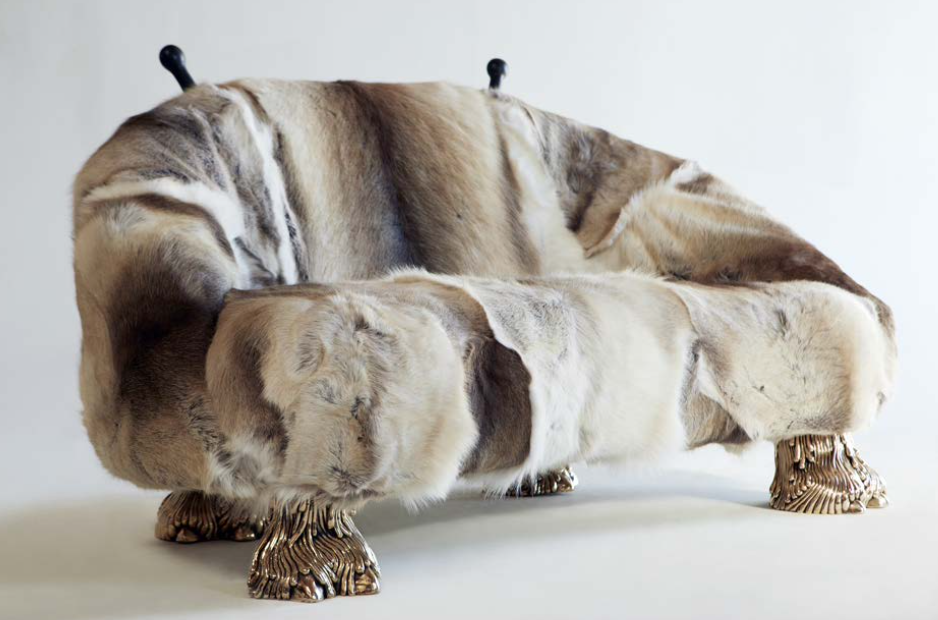
Speaking of movie references, that sofa over there looks like it’s straight out of The Never Ending Story!
NH: Awesome! most people say Where The Wild Things Are and I always think The Never Ending Story is more accurate. We’re into having been influenced by watching that, or having Garbage Pail Kids cards, or watching Ren & Stimpy — anything we experience we process.
NH: I’m really into Anna Nicole right now. I drew all these ceramics based on her that we’re going to be making next. I love this one photo of Anna Nicole with her tits out and she’s looking super hot.
Your work strikes a balance between references and abstraction. Do you know the Mexican artist and designer Pedro Friedeberg? I see him as a bit of a forefather to your school of work.
NH: Yeah. There is also some mid-century Italian stuff that’s more jokey with animal forms. But in general the word “design” adds a lot of heavy restrictions. People working under “design” instead of “art” tend to give themselves too many boundaries.
Well most designers learn the parameters of what’s considered worthwhile design in design school...
NH: ...while we’re coming from a really uneducated place. [Laughs.] I do know about sculpture and music, though.
SH: But we don’t have the burden of design history. That’s part of why I left school — I didn’t want all these ideas in my head. I like coming up with stuff myself. It’s a little stupid to say, but we don’t really care — we make what we want to make.
NH: That’s really what it is. We’re just making a bunch of stuff. and it just happened that furniture is the venue we fell into, and we love working in it. It’s really fun.
SH: It’s all about having a more relatable piece. We want you to think of Falcor [the dragon in The Never Ending Story] because you already have an association with it.
NH: When we first started, I would always have this discussion with my girlfriend about how modern furniture feels very cold. Living spaces should feel dynamic, modern, and new. Not like some old-hat mid-century stuff, which I love, but it’s old. I think a lot more people are going to get into the anthropomorphic, the sexual, and the humanist. We’re lucky to be on the forefront of that.
SH: For us it’s such a no-brainer. and people are going way sex right now!
